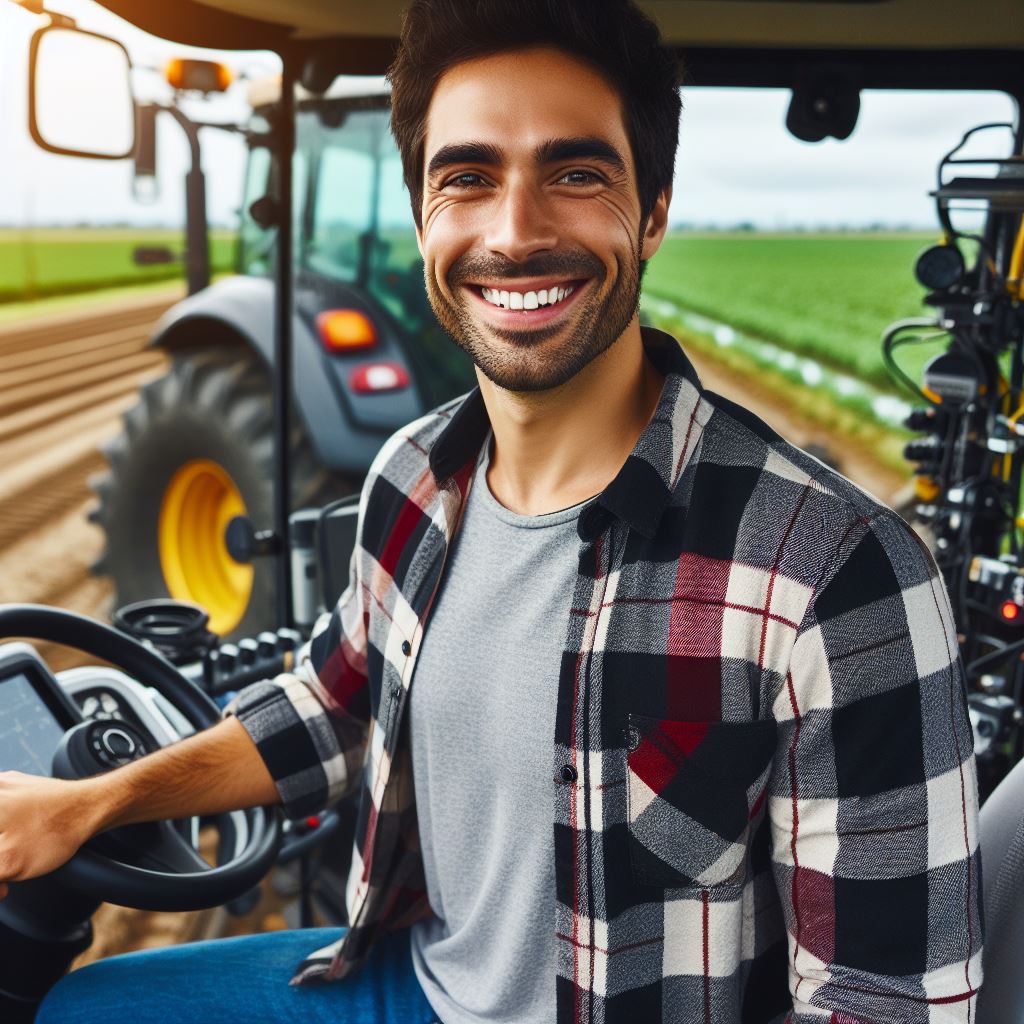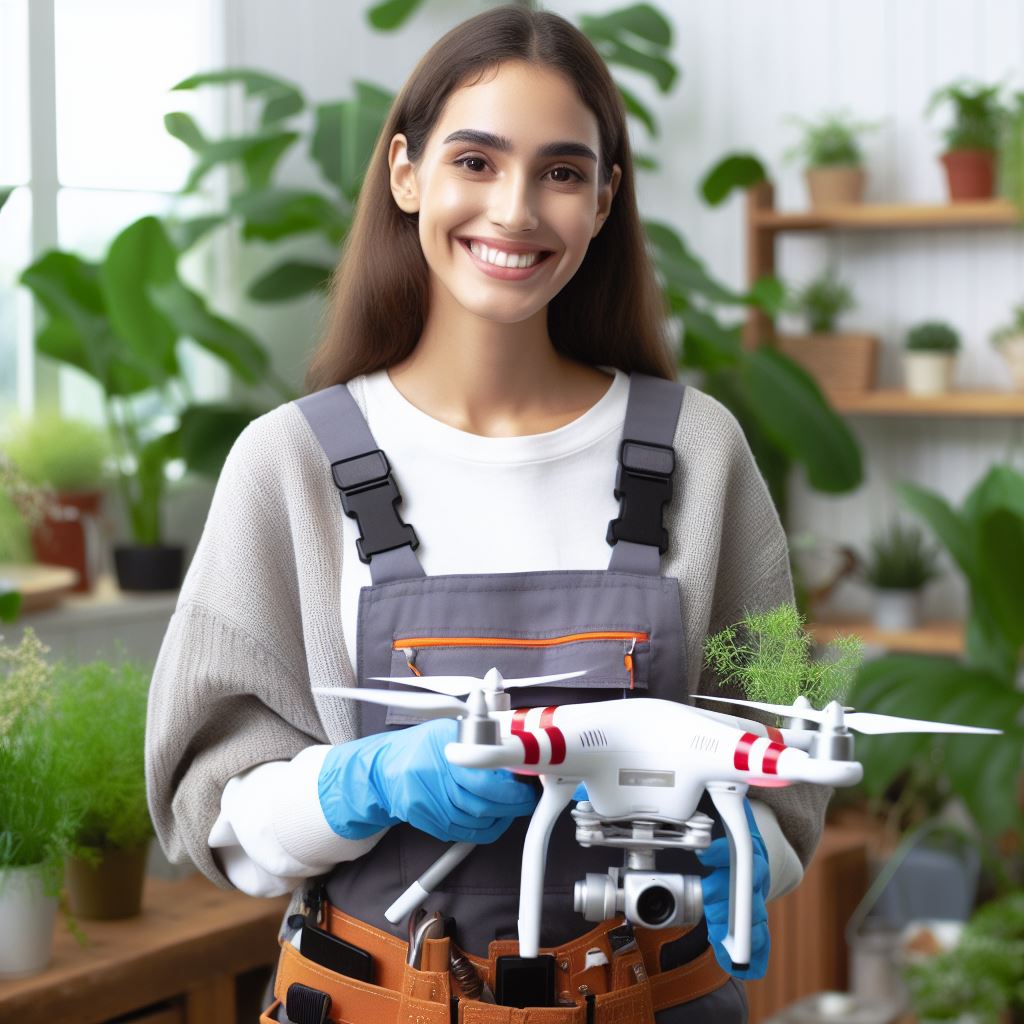Introduction
Drones have revolutionized various industries, and agriculture is no exception.
These unmanned aerial vehicles are being increasingly used for crop monitoring, providing farmers with valuable insights and improving overall productivity.
Crop monitoring in agriculture is essential for identifying issues such as diseases, nutrient deficiencies, and pests.
Timely detection of these issues allows farmers to take necessary action, prevent crop damage, and maximize harvest yields.
Traditional monitoring techniques, such as manual scouting or satellite imagery, have limitations in terms of cost, accuracy, and accessibility.
The advent of drones has transformed crop monitoring by offering a more efficient and cost-effective solution.
Equipped with high-resolution cameras, multispectral sensors, and thermal imaging capabilities, drones can capture detailed images and collect data at a fraction of the time and cost compared to conventional methods.
Using drones for crop monitoring provides several advantages.
They can rapidly cover large areas of farmland, identify early signs of crop stress, and create accurate field maps.
This enables farmers to precisely target areas requiring intervention, resulting in reduced resource wastage and improved sustainability.
Moreover, drones equipped with advanced software and data analytics can process and interpret the collected data, providing farmers with valuable insights and actionable recommendations.
This integration of technology further optimizes decision-making and enhances overall crop management practices.
In fact, the impact of drones on crop monitoring in agriculture is significant.
These unmanned aerial vehicles offer a cost-effective, efficient, and accurate solution for farmers to monitor their crops, detect issues early, and make informed decisions for maximizing yields while minimizing resource waste.
The adoption of drones in crop monitoring is poised to shape the future of agriculture and contribute to sustainable farming practices.
Benefits of using drones for crop monitoring
Drones have revolutionized the field of crop monitoring, offering numerous benefits to farmers and agricultural professionals.
In this section, we will explore the advantages of using drones for crop monitoring, including time-saving and efficiency, cost-effectiveness, and improved accuracy and data quality.
Timesaving and efficiency
One of the major advantages of using drones for crop monitoring is the ability to cover large areas quickly.
Drones can fly over fields and capture images or collect data much faster than manual methods.
This saves valuable time for farmers and allows them to monitor larger areas in a shorter period.
Additionally, drones offer automated flight planning and data collection.
With advanced software and technology, farmers can program drones to fly predetermined routes and collect data in an organized and systematic manner.
This eliminates the need for manual labor and reduces the time and effort required for crop monitoring.
Cost-effectiveness
Using drones for crop monitoring also brings significant cost savings for farmers.
By replacing manual labor with automated systems, farmers can reduce the labor costs associated with traditional monitoring methods.
Drones can cover large areas efficiently, requiring fewer resources and personnel.
Furthermore, drones help optimize resource allocation in crop monitoring.
By accurately capturing data and analyzing it in real-time, farmers can make informed decisions about resource allocation, such as irrigation, fertilization, and pest control.
This prevents unnecessary use of resources and saves money in the long run.
Improved accuracy and data quality
Drones provide high-resolution imaging capabilities, capturing detailed images of crops and their condition.
This level of imaging allows farmers to closely monitor the health of their crops, identify potential issues, and take timely action.
The data collected by drones is reliable and accurate, enabling farmers to make informed decisions about crop management.
Moreover, real-time data analysis and monitoring are made possible by using drones.
Farmers can receive instant updates on crop conditions, identify areas of concern, and respond effectively.
This real-time data analysis helps prevent crop damage and ensures timely interventions to optimize crop health and yield.
In short, the benefits of using drones for crop monitoring are evident in terms of timesaving and efficiency, cost-effectiveness, and improved accuracy and data quality.
Drones have become invaluable tools for farmers, providing them with the necessary information to make informed decisions, increase productivity, and optimize crop management practices.
As technology continues to advance, the use of drones in agriculture will likely become even more widespread, revolutionizing the way crops are monitored and managed.
Read: Nanotech in Farming: Small but Mighty
Transform Your Agribusiness
Unlock your farm's potential with expert advice tailored to your needs. Get actionable steps that drive real results.
Get StartedEnhanced crop health and disease detection
Drones have proven to be valuable tools in crop monitoring, offering improved efficiency and accuracy compared to traditional methods.
One of the key benefits drones bring to crop monitoring is the enhanced detection of crop health and diseases.
Early identification of crop stress factors
Drones equipped with various sensors can detect nutrient deficiencies in crops, enabling farmers to take early corrective measures.
The sensors analyze the reflection of light from plants to determine their nutrient status.
By identifying nutrient deficiencies early on, farmers can precisely apply fertilizers or adjust their irrigation practices to ensure optimal crop health and productivity.
Drones are also capable of identifying water stress in crops.
By analyzing the thermal patterns of plants, drones can identify areas with inadequate water supply.
This information allows farmers to promptly provide additional irrigation in those areas, preventing crop damage and yield losses.
Prompt detection of crop diseases and pests
Drones provide farmers with the ability to identify infected areas even before visible symptoms appear.
Drones can capture high-resolution images and use specialized software to analyze them, detecting subtle changes in plant color or shape that may indicate the presence of diseases or pests.
Early detection allows farmers to isolate and treat affected areas, preventing the spread of diseases and minimizing crop losses.
Furthermore, drones enable precision application of treatments.
By precisely targeting infected areas, farmers can use drones to deploy pesticides or fungicides only where necessary, minimizing their usage and reducing the environmental impact.
This not only saves costs but also reduces the risk of excessive chemical exposure on crops and surrounding ecosystems.
Overall, the impact of drones on crop monitoring is significant in terms of improved crop health and disease detection.
Early identification of crop stress factors, such as nutrient deficiencies and water stress, allows farmers to implement timely interventions and optimize crop productivity.
The prompt detection of crop diseases and pests enables farmers to take targeted actions, preventing the spread of infections and minimizing crop losses.
The use of drones in crop monitoring not only improves the accuracy of identifying crop health issues but also enhances the precision and efficiency of treatment applications.
With drones, farmers can make data-driven decisions and tailor their interventions based on specific crop needs.
This results in a more sustainable approach to agriculture, minimizing the use of resources like fertilizers and pesticides.
In essence, drones have revolutionized the way crop monitoring is conducted, bringing numerous benefits to farmers.
Enhanced crop health and disease detection through early identification of stress factors and precise treatment applications contribute to increased yields, reduced losses, and a more sustainable agricultural system.
Embracing drone technology in crop monitoring is a crucial step towards improving farm productivity and sustainability in the modern era.
Read: Farm Data Analysis: Improving Yields
Improved crop management and yield optimization
Plant health assessment and monitoring
In recent years, drones have revolutionized the agricultural industry by providing innovative solutions for crop monitoring.
This advanced technology has significantly improved crop management practices and optimized yields.
Through plant health assessment and monitoring, drones have facilitated precise interventions and resource allocation, resulting in enhanced productivity.
A significant advantage of using drones in crop monitoring is their ability to assess and monitor plant health.
By flying over fields and capturing high-resolution images, drones can identify areas that require immediate attention, such as fertilization or irrigation.
This enables farmers to precisely target these areas, avoiding excessive use of resources and reducing potential environmental impacts.
Additionally, drones can monitor growth patterns and development stages, allowing farmers to intervene at the right time, optimizing crop yield and quality.
Harvest forecasting and yield estimation
Furthermore, drones play a crucial role in harvest forecasting and yield estimation.
By collecting accurate data through aerial surveys, drones provide valuable inputs for yield prediction models.
These models consider various factors such as plant health, weather conditions, and soil quality to estimate future yields accurately.
This information helps farmers develop effective strategies for harvest planning, resource allocation, and marketing.
Real-time data provided by drones is another significant advantage in crop monitoring.
Farmers can access immediate and up-to-date information about their fields through live video feeds and data analysis.
This enables them to make timely decisions on cultivation practices, pest control, and disease management.
By having access to real-time data, farmers can respond quickly to any emerging issues, preventing potential crop losses and optimizing yields.
The integration of drones into crop management not only enhances productivity but also reduces manual labor and costs.
Traditional methods of monitoring fields require substantial time, effort, and manpower.
With drones, large areas can be surveyed quickly and efficiently, allowing farmers to focus their resources on specific areas requiring attention.
This optimization minimizes overall cultivation and management costs, benefiting farmers economically.
In review, the impact of drones on crop monitoring is evident in improved crop management and yield optimization.
The ability of drones to assess plant health, monitor growth patterns, and provide real-time data empowers farmers to make informed decisions.
The accurate data collected by drones also aids in harvest forecasting and yield estimation.
This advanced technology not only enhances productivity but also helps reduce labor and costs.
By embracing drones in agriculture, farmers can maximize their yields, improve sustainability, and contribute to the overall growth of the industry.
Read: Climate Smart Agriculture: Tech Solutions

Challenges and limitations of using drones for crop monitoring
Drones have revolutionized the way farmers monitor and manage their crops.
However, like any technology, there are challenges and limitations that need to be addressed for effective drone use in crop monitoring.
Legal and regulatory constraints
Drones operate in regulated airspace, and compliance with airspace regulations is a critical challenge.
Drone operators must ensure that they are aware of and follow all rules and restrictions imposed by aviation authorities.
Failure to comply can result in fines or even grounding of drone operations.
Another legal constraint is the licensing and certification requirements for drone operators.
Many countries require a permit or certification to operate a drone commercially.
This process involves training, passing exams, and acquiring insurance, which adds to the overall cost and complexity of using drones for crop monitoring.
Technical limitations
One key technical limitation is the battery life and flight time of drones.
Most drones have a limited battery capacity, limiting their flight duration.
This poses a constraint on covering large farms or fields efficiently, as drones may need to return to base frequently to recharge.
Weather and environmental conditions also affect drone flights.
Strong winds, rain, or extreme temperatures can hinder the capabilities and stability of drones.
These limitations may restrict the opportunities for drone-based crop monitoring, especially in regions with harsh weather conditions.
Data management and analysis
Collecting data is just the first step; managing and analyzing the vast amounts of data collected by drones is another challenge.
Drones can capture high-resolution images and sensor readings, generating terabytes of data.
Efficiently storing, processing, and analyzing this data requires specialized infrastructure and expertise.
Furthermore, integrating drone data with existing agricultural systems presents a challenge.
Drones produce data in different formats, and seamlessly integrating it with other software applications used in agriculture can be complex.
Creating standardized protocols for data sharing and interoperability is crucial to fully harness the benefits of drone-based crop monitoring.
In a nutshell, while drones offer immense potential for crop monitoring, several challenges and limitations persist.
Legal and regulatory constraints surrounding drone operations need to be addressed to ensure compliance and safety.
Technical limitations, such as battery life and weather conditions, must be accounted for in planning drone operations.
Lastly, efficient data management and integration with existing agricultural systems are essential for effective drone-based crop monitoring.
By addressing these challenges, the impact of drones on crop monitoring can be maximized, leading to improved yield and resource management in modern agriculture.
Showcase Your Farming Business
Publish your professional farming services profile on our blog for a one-time fee of $200 and reach a dedicated audience of farmers and agribusiness owners.
Publish Your ProfileRead: Hydroponics: High-Tech Farming Simplified
Future prospects and advancements
Drones have already proven their immense value in crop monitoring, revolutionizing the field of agriculture.
However, the future holds even more promising prospects and advancements for this technology.
Development of autonomous drones
1. Artificial intelligence and machine learning applications
With the rapid advancement of artificial intelligence and machine learning, drones can be equipped with algorithms that enable them to make independent decisions based on collected data.
These drones can analyze crop health, identify diseases, and even suggest appropriate interventions.
2. Improved accuracy and decision-making capabilities
As drones continue to evolve, they will become even more accurate in collecting and analyzing data.
Advanced sensors and imaging technology will allow drones to capture high-resolution images, thermal data, and multispectral imagery.
This will provide farmers with precise and actionable insights for effective crop monitoring.
Integration of drone technology with other agricultural tools
1. Collaboration with satellite imagery and remote sensing
Drones can work in tandem with satellite imagery and remote sensing techniques to enhance agricultural monitoring.
Combining drone data with satellite data allows for a broader and more comprehensive view of crop health, enabling farmers to identify issues across large areas of land.
2. Integration with precision farming systems
Precision farming systems aim to optimize agricultural practices by using data-driven insights.
Drones can play a significant role in these systems by providing real-time data on crop health, soil moisture, and pest infestations.
This integration will enable farmers to precisely target interventions, reducing waste and maximizing yields.
The integration of autonomous drones and other agricultural tools holds immense potential for transforming crop monitoring and management.
By leveraging artificial intelligence and machine learning, drones can become intelligent and autonomous devices capable of adapting to changing environmental conditions.
Furthermore, the collaboration between drones and satellite imagery or remote sensing technologies provides a comprehensive and holistic approach to crop monitoring.
This synergy enables farmers to gain a deeper understanding of their crops’ health and make informed decisions regarding irrigation, fertilization, and pest control.
Moreover, the integration of drone technology with precision farming systems allows for a more efficient use of resources.
Farmers can avoid unnecessary treatments by identifying specific areas that require intervention, resulting in reduced costs and environmental impact.
In general, the future of drones in crop monitoring looks promising.
The development of autonomous drones equipped with artificial intelligence and machine learning capabilities will significantly enhance their accuracy and decision-making capabilities.
Additionally, integrating drone technology with other agricultural tools like satellite imagery and precision farming systems will provide a holistic approach to crop management.
With these advancements, farmers can expect more efficient and sustainable farming practices, ultimately leading to increased yields and reduced environmental impacts.
Conclusion
Recap the benefits of drones for crop monitoring
Drones have revolutionized the way farmers monitor their crops.
With their ability to capture high-resolution imagery and collect data in real-time, drones provide invaluable insights into crop health, growth patterns, and potential issues such as pest infestations or nutrient deficiencies.
Moreover, drones offer cost efficiency by reducing the need for manual labor and expensive equipment like helicopters or satellites.
Additionally, their precise analysis capabilities allow farmers to make informed decisions promptly, leading to more effective crop management strategies.
The potential for improved crop management
The potential of drones in improving crop management is vast.
By leveraging the data gathered by drones, farmers can implement proactive measures to address issues before they escalate, such as adjusting irrigation schedules or applying targeted treatments.
This proactive approach not only optimizes resource allocation but also contributes to increased yields and overall farm profitability.
Furthermore, drones enable farmers to monitor large areas of land efficiently, ensuring that every corner of the farm receives the attention it needs for optimal productivity.
The need for addressing challenges and embracing future advancements in this area.
Despite the numerous benefits drones offer for crop monitoring, several challenges must be addressed to fully capitalize on their potential.
Regulatory hurdles, such as airspace restrictions and privacy concerns, need to be navigated to ensure the safe and ethical use of drones in agriculture.
Additionally, managing the vast amounts of data collected by drones requires robust systems and infrastructure, including data storage, processing, and analysis tools.
Moreover, ongoing advancements in drone technology, such as improved battery life, increased payload capacity, and enhanced sensors, should be embraced to further enhance their capabilities and effectiveness in crop management.
By addressing these challenges and embracing future advancements, farmers can harness the full potential of drones to revolutionize crop monitoring and drive sustainable agricultural practices.




